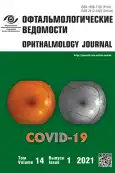Effects of treatment interruption on anatomical and functional status of eyes with neovascular age-related macular degeneration receiving anti-VEGF therapy
- 作者: Kharakozov A.S.1, Kulikov A.N.1, Maltsev D.S.1
-
隶属关系:
- S.M. Kirov Military Medical Academy
- 期: 卷 14, 编号 1 (2021)
- 页面: 35-42
- 栏目: Original study articles
- URL: https://journals.rcsi.science/ov/article/view/59966
- DOI: https://doi.org/10.17816/OV59966
- ID: 59966
如何引用文章
详细
AIM: To study anatomical and functional changes in eyes with neovascular age-related macular degeneration (AMD) receiving anti-VEGF therapy and experienced treatment interruption during COVID pandemic.
MATERIAL AND METHODS: This retrospective study included 58 eyes (49 patients, 34 males and 15 females with a mean age of 73.2 ± 9.4 years) with nAMD. Eyes in the first-year treatment group (18 eyes) received up to 7 intravitreal aflibercept injections, eyes in the second-year treatment group (21 eyes) were treated with pro re nata regimen. The treatment interruption period in the first and second-year treatment group was 5.5 ± 0.7 and 5.5 ± 1.0 months, respectively.
RESULTS: Over the treatment interruption period, the first-year treatment group showed no statistically significant differences in best-corrected visual acuity (BCVA) and central retinal thickness (CRT), p = 0.25 and p = 0.09, respectively. At the same time, the second-year treatment group showed a statistically significant decrease in BCVA (p = 0.0004) and an increase in CRT (p = 0.002). Baseline BCVA was positively associated with BCVA at the end of treatment interruption (r = 0.82; p < 0.0001). Presence of sub- and intraretinal fluid (p = 0.015 and p = 0.007, respectively), low BCVA (p < 0.0001), high CRT (p = 0.019), alteration of the ellipsoid zone (p < 0.001) were negatively associated with BCVA at the end of treatment interruption. Age (p = 0.8), gender (p = 0.41), and the number of intravitreal injections (p = 0.5) showed no association with changes in BCVA.
CONCLUSIONS: NAMD patients of the second year of anti-VEGF therapy appear to have a higher risk of functional loss during treatment interruption. Higher CRT and lower BCVA, as well as sub- and intraretinal fluid before treatment interruption, are associated with poorer functional status at the end of the interruption period.
作者简介
Alexandr Kharakozov
S.M. Kirov Military Medical Academy
编辑信件的主要联系方式.
Email: kharakozoff@mail.ru
ORCID iD: 0000-0003-4598-0826
SPIN 代码: 1208-5237
graduated
俄罗斯联邦, 6 Aсademiс Lebedev str., Saint Petersburg, 194044Alexey Kulikov
S.M. Kirov Military Medical Academy
Email: alexey.kulikov@mail.ru
ORCID iD: 0000-0002-5274-6993
SPIN 代码: 6440-7706
Scopus 作者 ID: 57001225300
Researcher ID: M-2094-2016
MD, PhD, Dr. Sci. (Med.)
俄罗斯联邦, 6 Aсademiс Lebedev str., Saint Petersburg, 194044Dmitrii Maltsev
S.M. Kirov Military Medical Academy
Email: glaz.med@yandex.ru
ORCID iD: 0000-0001-6598-3982
MD, PhD
俄罗斯联邦, 6 Aсademiс Lebedev str., Saint Petersburg, 194044参考
- Regillo CD, Busbee BG, Ho AC, et al. Baseline predictors of 12-Month treatment response to ranibizumab in patients with wet age-related macular degeneration. Am J Ophthalmol. 2015;160(5):1014–1023. doi: 10.1016/j.ajo.2015.07.034
- Hayashi H, Yamashiro K, Tsujikawa A, et al. Association between foveal photoreceptor integrity and visual outcome in neovascular age-related macular degeneration. Am J Ophthalmol. 2009;148(1):83–89. doi: 10.1016/j.ajo.2009.01.017
- Kharakozov AS, Kulikov AN, Maltsev DS. Predictors of functional outcome of antiangiogenic therapy in neovascular age-related macular degeneration. Ophthalmology Journal. 2020;13(4):7-13. (In Russ.)] doi: 10.17816/OV46198
- Ou WC, Brown DM, Payne JF, et al. Relationship between visual acuity and retinal thickness during anti-vascular endothelial growth factor therapy for retinal diseases. Am J Ophthalmol. 2017;180:8–17. doi: 10.1016/j.ajo.2017.05.014
- Boiko EV, Maltsev DS. Quantitative optical coherence tomography analysis of retinal degenerative changes in diabetic macular edema and neovascular age-related macular degeneration. Retina. 2018;38(7):1324–1330. doi: 10.1097/IAE.0000000000001696
- Kulikov AN, Sosnovskii SV, Berezin RD, et al. Vitreoretinal interface abnormalities in diabetic macular edema and effectiveness of anti-VEGF therapy: an optical coherence tomography study. Clin Ophthalmol. 2017;11:1995–2002. doi: 10.2147/OPTH.S146019
- American Academy of Ophthalmology. Alert: Important coronavirus updates for ophthalmologists. March 23, 2020. Available at: https://www.aao.org/headline/alert-important-coronavirus-context. Accessed: 25.03.2021.
- Antaki F, Dirani A. Treating neovascular age-related macular degeneration in the era of COVID-19. Graefes Arch Clin Exp Ophthalmol. 2020;258(7):1567–1569. doi: 10.1007/s00417-020-04693-w
- Wong DHT, Mak ST, Yip NKF, et al. Protective shields for ophthalmic equipment to minimise droplet transmission of COVID-19. Graefes Arch Clin Exp Ophthalmol. 2020;258(7):1571–1573. doi: 10.1007/s00417-020-04683-y
- Sacconi R, Borrelli E, Vella G, et al. TriPla regimen: A new treatment approach for patients with neovascular age-related macular degeneration in the COVID-19 “era”. Eur J Ophthalmol. 2020;7:1120672120963448. doi: 10.1177/1120672120963448
- The Royal College of Ophthalmologists (2020) Medical retinal management plans during COVID-19. Available at: https://www.rcophth.ac.uk/wp-content/uploads/2020/03/Medical-Retinal-Management-Planduring-COVID-19-UPDATED-300320-1-2.pdf. Accessed 25.03.2021.
补充文件










